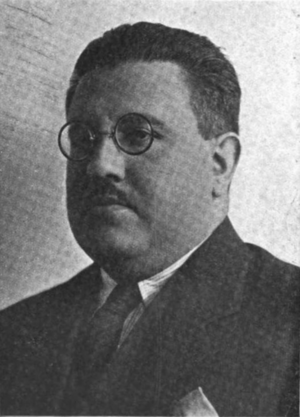Pedro Sainz Rodríguez facts for kids
Quick facts for kids
The Most Excellent
Pedro Sainz Rodríguez
|
|
|---|---|
 |
|
| Born | 14 January 1897 Madrid, Spain
|
| Died | 14 December 1986 (aged 89) Madrid, Spain
|
| Seat c of the Real Academia Española | |
| In office 10 June 1979 – 14 December 1986 |
|
| Preceded by | Amalio Gimeno |
| Succeeded by | Manuel Fernández-Galiano |
Pedro Sainz Rodríguez (born January 14, 1897, in Madrid – died December 14, 1986) was an important Spanish writer, expert in language and literature (a philologist), publisher, and politician. He was a key advisor to Infante Juan, Count of Barcelona. He also played a big part in helping Juan Carlos I of Spain become king and in Spain's move towards democracy.
Pedro Sainz Rodríguez was known for his quick thinking and cleverness. He was a leading figure among the monarchists, who wanted a king to rule Spain.
Contents
Becoming a Scholar and Writer
Pedro Sainz Rodríguez first became well-known as a scholar of language and literature. He was a student of Marcelino Menéndez y Pelayo, a famous Spanish scholar. Pedro became an expert in the spiritual writings from Spain's "Golden Age." He strongly supported traditional Catholicism.
He believed that Spain had become weaker because of new ideas like liberalism that came from the 18th century. He wanted Spain to return to its Catholic values and the brave spirit of characters like Don Quixote. His 1925 book, La evolución de las ideas sobre la decadencia española, was very popular. It talked about why Spain might have declined, which was a common topic for writers at that time.
Working with Francisco Franco
Pedro Sainz Rodríguez was a friend of Francisco Franco. He helped convince Franco to join a plan by other generals to overthrow the government. This plan led to the start of the Spanish Civil War. Pedro was close to General Emilio Mola. Like Mola, he thought Franco would only be in charge for a short time because of his popularity.
Even though he had some doubts about Franco's leadership, Pedro Sainz Rodríguez became the Minister of Education in 1938. This was part of Franco's first government. As Minister, Pedro made sure that the Church would once again have a strong influence over education in Spain.
He also strongly opposed some ideas from the Falangist party, which wanted Spain to become a one-party state like Fascist Italy or Nazi Germany. Franco supported Pedro in this opposition. Because of his disagreements with the Falangists, Pedro faced a lot of criticism. He asked to leave his position in April 1939 and was replaced later that year.
Supporting the Monarchy
After leaving the government, Pedro Sainz Rodríguez became more focused on bringing back the monarchy. In 1943, he was involved in a plan with Generals Antonio Aranda and Luis Orgaz Yoldi to restore the king. However, this plan did not happen.
He remained dedicated to the idea of a king ruling Spain. He became one of the three main advisors to Infante Juan, Count of Barcelona, who was the son of the last king and the father of future King Juan Carlos I. During World War II, he also worked with Samuel Hoare. Hoare's job was to make sure Spain did not join the Axis powers.
Franco became more distant from Pedro Sainz Rodríguez. Franco even accused Pedro of being part of a Masonic plot to criticize Spain internationally. Even though there was no proof, Franco kept repeating these accusations. When a book came out that criticized the idea of a monarchy as a Masonic plot, Franco told Juan that he agreed with many of its ideas because of Pedro's role. However, Juan did not agree with Franco and kept Pedro as a close advisor.
Later Years and Writings
In his later years, Pedro Sainz Rodríguez became known for writing many books about the history of spirituality in Spain. Some of his works include Historica de la literatura mística en España (1984). He also wrote a four-volume series called Antología de la literatura espiritual español (1980-1985).
His autobiography, which is a book about his own life, was published after Franco's death. In it, he wrote about how his relationship with Franco had worsened over time. Like many others who wrote their memoirs after Franco died, Pedro described Franco as a rather ordinary person.
See also
 In Spanish: Pedro Sainz Rodríguez para niños
In Spanish: Pedro Sainz Rodríguez para niños

